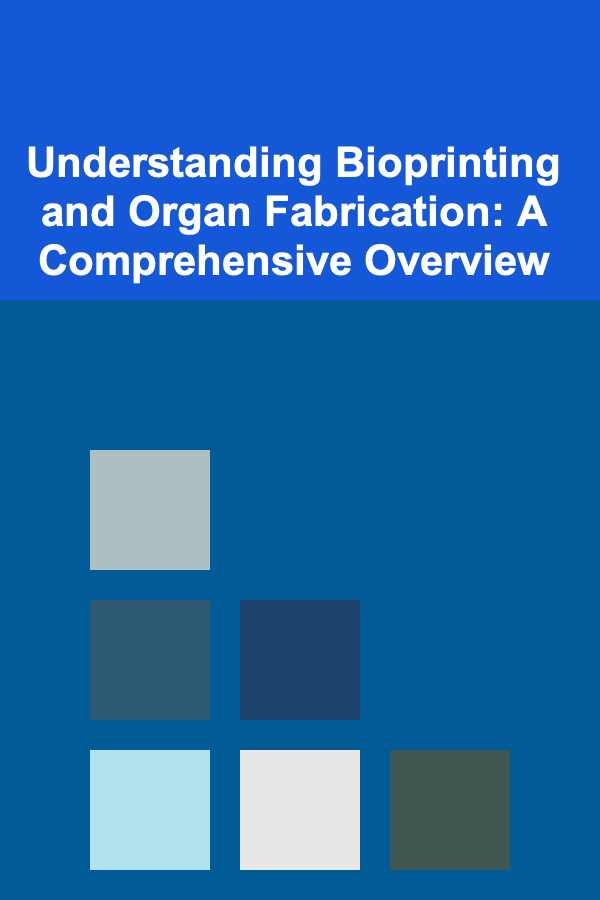
Understanding Bioprinting and Organ Fabrication: A Comprehensive Overview
ebook include PDF & Audio bundle (Micro Guide)
$12.99$7.99
Limited Time Offer! Order within the next:

Introduction: The Promise of 3D Bioprinting
The field of medicine is constantly evolving, driven by the relentless pursuit of better treatments and improved patient outcomes. One of the most groundbreaking advancements on the horizon is 3D bioprinting, a revolutionary technology poised to transform healthcare by enabling the creation of functional tissues and, potentially, whole organs. While still in its early stages, bioprinting holds immense promise for addressing critical challenges such as organ shortages, personalized medicine, and improved drug development. This article provides a comprehensive overview of bioprinting, exploring its fundamental principles, key techniques, applications, challenges, and future directions.
Organ transplantation is a life-saving procedure for individuals suffering from end-stage organ failure. However, the demand for organs far exceeds the supply, leading to long waiting lists and, tragically, the death of many patients before they can receive a transplant. Furthermore, even with successful transplants, patients require lifelong immunosuppressant drugs to prevent organ rejection, which can have significant side effects. Bioprinting offers a potential solution to these problems by providing a means to create custom-made organs using a patient's own cells, eliminating the risk of rejection and significantly reducing the dependence on donor organs.
Beyond organ transplantation, bioprinting has the potential to revolutionize drug development. Instead of relying on animal models or traditional cell cultures, researchers can use bioprinted tissues to create more accurate and physiologically relevant models for testing new drugs. This can lead to more effective and safer medications, as well as a reduction in the use of animals in research. Furthermore, bioprinting can be used to create personalized drug therapies, tailored to the specific needs of individual patients.
Fundamentals of 3D Bioprinting
3D bioprinting is an additive manufacturing process that uses a computer-controlled system to deposit cells, biomaterials, and growth factors in a layer-by-layer fashion to create three-dimensional tissue constructs. The process typically involves three main stages: pre-bioprinting, bioprinting, and post-bioprinting.
Pre-Bioprinting: Design and Preparation
The pre-bioprinting stage involves the design and preparation required before the actual printing process. This crucial phase determines the architecture and functionality of the final bioprinted construct. It includes the following key steps:
- Imaging and Modeling: High-resolution imaging techniques such as computed tomography (CT) scans and magnetic resonance imaging (MRI) are used to create detailed 3D models of the target tissue or organ. These models serve as blueprints for the bioprinting process. Computational modeling is often employed to optimize the design and predict the mechanical and biological properties of the bioprinted construct.
- Cell Sourcing and Preparation: The choice of cell type is critical for the success of bioprinting. Cells can be harvested from the patient (autologous), a donor (allogeneic), or derived from stem cells. Stem cells, such as induced pluripotent stem cells (iPSCs), are particularly attractive as they can be differentiated into a wide range of cell types. Prior to bioprinting, cells must be cultured and expanded to obtain a sufficient number for printing.
- Bioink Development: Bioinks are the materials used to encapsulate and deliver cells during the bioprinting process. They must possess several important characteristics, including biocompatibility, printability, and the ability to support cell survival and function. Common bioink materials include hydrogels (e.g., collagen, gelatin, alginate, hyaluronic acid), decellularized extracellular matrix (dECM), and cell aggregates (spheroids). The choice of bioink depends on the specific application and the cell type being used. The bioink also serves as a scaffold and structural support until the cells can produce their own extracellular matrix.
Bioprinting: The Layer-by-Layer Process
The bioprinting stage involves the actual deposition of bioink layers to create the 3D construct. Several different bioprinting techniques have been developed, each with its own advantages and disadvantages.
- Extrusion-Based Bioprinting: This is the most common bioprinting technique. It involves extruding bioink through a nozzle onto a substrate. The bioink is typically delivered using a pneumatic or mechanical dispensing system. Extrusion-based bioprinting is relatively simple and versatile, but it can be limited by the resolution and the viscosity of the bioink.
- Inkjet-Based Bioprinting: This technique uses thermal or piezoelectric actuators to eject small droplets of bioink onto a substrate. Inkjet bioprinting offers high resolution and precise control over cell deposition, but it is limited by the viscosity and cell density of the bioink.
- Laser-Induced Forward Transfer (LIFT) Bioprinting: LIFT bioprinting uses a laser to transfer bioink from a donor ribbon onto a receiving substrate. This technique offers high resolution and the ability to print a wide range of materials, but it can be complex and expensive.
During the printing process, the bioprinting system precisely controls the movement of the nozzle or laser, depositing the bioink layer by layer according to the pre-designed model. Support structures may be used to provide mechanical support during the printing process, particularly for complex geometries.
Post-Bioprinting: Maturation and Functionalization
The post-bioprinting stage involves the maturation and functionalization of the bioprinted construct. This is a critical step to ensure that the cells within the construct differentiate, proliferate, and form functional tissues.
- Incubation and Culture: The bioprinted construct is incubated in a bioreactor, a controlled environment that provides the necessary nutrients, oxygen, and growth factors for cell survival and differentiation. The bioreactor can also provide mechanical stimulation to promote tissue development.
- Crosslinking: Crosslinking is often used to improve the mechanical properties of the bioprinted construct. This can be achieved using chemical crosslinkers, light-activated crosslinkers, or enzymatic crosslinkers.
- Functionalization: Functionalization involves adding specific signals or cues to the bioprinted construct to promote tissue-specific functions. This can include adding growth factors, extracellular matrix proteins, or mechanical stimuli.
Key Bioprinting Techniques in Detail
Extrusion-Based Bioprinting: A Workhorse of the Field
Extrusion-based bioprinting, also known as microextrusion bioprinting, is one of the most widely used and versatile bioprinting techniques. It relies on the controlled dispensing of bioink through a nozzle or needle to create 3D structures layer by layer. The bioink is typically delivered via a pressure-driven system (pneumatic or mechanical) or a piston-driven system.
Mechanism: The bioink is loaded into a cartridge or syringe and then forced through a nozzle with a defined diameter. The movement of the nozzle, controlled by a computer-aided design (CAD) program, precisely deposits the bioink onto a substrate, creating the desired 3D structure. Layer-by-layer deposition is repeated until the entire construct is formed.
Advantages:
- Versatility: Compatible with a wide range of bioinks, including hydrogels, cell suspensions, and composite materials.
- Scalability: Suitable for creating both small and large-scale tissue constructs.
- Cost-effectiveness: Relatively simple and affordable compared to other bioprinting techniques.
Disadvantages:
- Resolution limitations: The nozzle diameter limits the printing resolution, which may not be sufficient for creating complex microstructures.
- Cell damage: Shear stress experienced by cells during extrusion can potentially reduce cell viability.
- Bioink viscosity requirements: Bioinks must have sufficient viscosity to be extruded effectively, which can limit the types of materials that can be used.
Applications: Extrusion-based bioprinting has been used to create a variety of tissues, including skin, bone, cartilage, and vascular networks. It is also widely used for drug screening and tissue engineering applications.
Inkjet-Based Bioprinting: Precision Droplet Deposition
Inkjet-based bioprinting utilizes the principles of inkjet printing to deposit small droplets of bioink onto a substrate. This technique offers high precision and control over cell placement, making it suitable for creating complex and intricate tissue structures.
Mechanism: Inkjet bioprinting employs two primary mechanisms for droplet generation: thermal and piezoelectric actuation. Thermal inkjet bioprinting uses heat to create vapor bubbles that eject droplets of bioink from the nozzle. Piezoelectric inkjet bioprinting uses a piezoelectric material to generate pressure waves that eject droplets.
Advantages:
- High resolution: Capable of printing with high resolution and precise cell placement.
- High throughput: Can print multiple droplets simultaneously, enabling high-throughput bioprinting.
- Non-contact printing: Reduces the risk of contamination and cell damage compared to extrusion-based bioprinting.
Disadvantages:
- Bioink limitations: Limited to low-viscosity bioinks with low cell densities.
- Nozzle clogging: Nozzles can easily become clogged, particularly with bioinks containing cells or particles.
- Cell viability concerns: The rapid heating and cooling cycles in thermal inkjet bioprinting can potentially reduce cell viability.
Applications: Inkjet-based bioprinting has been used to create skin grafts, vascular networks, and cell-laden microarrays for drug screening. It is also being explored for creating personalized cell therapies.
Laser-Induced Forward Transfer (LIFT) Bioprinting: High-Resolution Cell Placement
Laser-induced forward transfer (LIFT) bioprinting is a sophisticated technique that uses a focused laser beam to transfer bioink from a donor substrate onto a receiving substrate. LIFT bioprinting offers high resolution and the ability to print a wide range of materials, including highly viscous bioinks.
Mechanism: LIFT bioprinting involves three main components: a laser source, a donor substrate coated with a bioink layer, and a receiving substrate. The laser beam is focused onto the donor substrate, causing the bioink to evaporate or ablate, creating a small droplet that is propelled towards the receiving substrate. The laser scanning path is computer controlled.
Advantages:
- High resolution: Capable of achieving very high printing resolution and precise cell placement.
- Versatility: Can print a wide range of bioinks, including highly viscous materials.
- Non-contact printing: Reduces the risk of contamination and cell damage.
Disadvantages:
- Complexity and cost: LIFT bioprinting is a complex and expensive technique.
- Throughput limitations: LIFT bioprinting is relatively slow compared to other bioprinting techniques.
- Laser-induced cell damage: The laser beam can potentially damage cells, although optimized laser parameters can minimize this effect.
Applications: LIFT bioprinting has been used to create complex tissue structures, such as vascular networks and neural tissues. It is also being explored for creating cell-based biosensors and microfluidic devices.
Applications of Bioprinting: Transforming Healthcare
Bioprinting has a wide range of potential applications across various fields of medicine, offering solutions to some of the most pressing healthcare challenges.
Organ Transplantation: Addressing the Organ Shortage
The most ambitious and highly sought-after application of bioprinting is the creation of functional human organs for transplantation. The current shortage of donor organs leads to long waiting lists and the tragic death of many patients. Bioprinting offers the potential to create personalized organs using a patient's own cells, eliminating the risk of rejection and significantly reducing the dependence on donor organs.
While the creation of fully functional, complex organs like the heart or liver is still a long-term goal, significant progress has been made in bioprinting simpler tissues and organ components, such as skin grafts, blood vessels, and cartilage. These bioprinted tissues can be used to treat burns, repair damaged blood vessels, and regenerate damaged cartilage.
Drug Discovery and Development: Improved Testing Models
Traditional drug development relies heavily on animal models and 2D cell cultures, which often fail to accurately predict the efficacy and toxicity of drugs in humans. Bioprinting offers the potential to create more accurate and physiologically relevant 3D tissue models for drug screening and testing.
Bioprinted tissues can mimic the complex microenvironment of human tissues, including cell-cell interactions, extracellular matrix composition, and vascular networks. This allows researchers to assess the effects of drugs on human tissues in a more realistic setting, leading to more effective and safer medications.
Furthermore, bioprinting can be used to create personalized drug therapies, tailored to the specific needs of individual patients. By bioprinting tissues from a patient's own cells, researchers can test the efficacy of different drugs on that patient's tissue, identifying the most effective treatment option.
Regenerative Medicine: Healing Damaged Tissues
Bioprinting can be used to create scaffolds that promote tissue regeneration and healing. These scaffolds can be implanted into damaged tissues to provide structural support and guide cell growth, accelerating the healing process.
For example, bioprinted skin grafts can be used to treat burns and wounds, while bioprinted bone scaffolds can be used to repair bone fractures. Bioprinting can also be used to create nerve conduits that guide the regeneration of damaged nerves, restoring lost function.
Personalized Medicine: Tailored Treatments for Individuals
Bioprinting is poised to play a crucial role in the advancement of personalized medicine. By using a patient's own cells, bioprinting can create custom-made tissues and organs that are perfectly matched to the patient's immune system, eliminating the risk of rejection.
This personalized approach can be used to create custom-made implants, drug therapies, and diagnostic tools, tailored to the specific needs of each individual patient. Personalized medicine promises to revolutionize healthcare by providing more effective and targeted treatments, leading to improved patient outcomes.
Other Applications: Beyond the Obvious
Bioprinting's applications extend beyond the immediate fields of organ replacement and drug testing. Researchers are exploring its use in:
- Cosmetics Testing: Creating human skin models to test the safety and efficacy of cosmetic products, reducing the reliance on animal testing.
- Food Production: Bioprinting meat products, potentially offering a more sustainable and ethical alternative to traditional animal agriculture. This is a nascent field with significant hurdles but holds long-term potential.
- Fundamental Biology Research: Creating complex 3D models of tissues to study cell behavior, tissue development, and disease mechanisms.
Challenges and Future Directions
Despite the immense promise of bioprinting, several challenges remain before it can be widely adopted in clinical practice.
Technical Challenges
- Scalability: Bioprinting complex, fully functional organs requires the ability to print large-scale constructs with intricate microstructures. Scaling up bioprinting processes while maintaining high resolution and cell viability remains a significant challenge.
- Vascularization: Creating functional vascular networks within bioprinted tissues is essential for providing nutrients and oxygen to cells. Developing techniques for bioprinting complex and interconnected vascular networks is a major hurdle.
- Bioink Development: Developing bioinks that are biocompatible, printable, and able to support cell survival and function is crucial for the success of bioprinting. New bioinks with improved mechanical properties, biodegradability, and cell signaling capabilities are needed.
- Long-term Functionality: Ensuring the long-term functionality and stability of bioprinted tissues after implantation is essential. Further research is needed to understand the factors that influence tissue maturation and long-term survival.
Regulatory and Ethical Considerations
As bioprinting technology advances, it is essential to address the regulatory and ethical considerations associated with the creation and use of bioprinted tissues and organs.
- Regulatory Framework: Clear regulatory guidelines are needed to ensure the safety and efficacy of bioprinted products. These guidelines should address issues such as manufacturing standards, quality control, and clinical trial protocols.
- Ethical Concerns: The creation of human organs raises ethical concerns about the ownership of tissues, the potential for misuse of the technology, and the societal impact of widespread organ replacement.
- Accessibility: Ensuring equitable access to bioprinting technologies is crucial. Efforts should be made to make these technologies affordable and accessible to all patients, regardless of their socioeconomic status.
Future Directions
The future of bioprinting is bright, with ongoing research and development efforts focused on addressing the existing challenges and expanding the applications of this transformative technology.
- Advanced Bioprinting Techniques: Researchers are developing new bioprinting techniques that offer improved resolution, control, and scalability. These techniques include volumetric bioprinting, which uses light to create 3D structures in a single step, and microfluidic bioprinting, which allows for precise control over cell placement and microenvironment.
- Smart Bioinks: The development of "smart" bioinks that respond to environmental stimuli, such as pH, temperature, or light, will enable the creation of more dynamic and functional tissues. These bioinks can be used to deliver drugs, release growth factors, or trigger tissue regeneration.
- Integration with Other Technologies: Integrating bioprinting with other technologies, such as microfluidics, nanotechnology, and artificial intelligence, will further enhance the capabilities of bioprinting. This integration will enable the creation of more complex and sophisticated tissues and organs.
- Clinical Trials: As bioprinting technology matures, clinical trials will be essential for evaluating the safety and efficacy of bioprinted tissues and organs in humans. Successful clinical trials will pave the way for the widespread adoption of bioprinting in clinical practice.
Conclusion: A Revolution in Regenerative Medicine
3D bioprinting is a rapidly evolving field with the potential to revolutionize healthcare by enabling the creation of functional tissues and organs. While significant challenges remain, the ongoing research and development efforts are paving the way for the widespread adoption of bioprinting in clinical practice. From addressing the organ shortage to improving drug development and enabling personalized medicine, bioprinting promises to transform the way we treat diseases and improve human health. As the technology matures and becomes more accessible, it is likely to have a profound impact on the future of medicine and regenerative therapies, offering hope for patients suffering from a wide range of debilitating conditions. The journey from lab to clinic is a complex one, but the potential benefits of bioprinting make it a worthwhile endeavor, promising a future where damaged tissues and failing organs can be replaced with custom-made, functional replacements.

Content Writer's Handbook: Strategies for Creating High-Impact Content Across Platforms
Read More
How to Create a Home Office Storage System
Read More
How to Save for a Big Purchase Without Stress
Read More
How to Use Furniture with Hidden Storage for Organization
Read More
How to Use Citizen Science Projects in Astronomy
Read More
10 Tips for Guitarists: Structuring Your Practice with a Planner
Read MoreOther Products

Content Writer's Handbook: Strategies for Creating High-Impact Content Across Platforms
Read More
How to Create a Home Office Storage System
Read More
How to Save for a Big Purchase Without Stress
Read More
How to Use Furniture with Hidden Storage for Organization
Read More
How to Use Citizen Science Projects in Astronomy
Read More